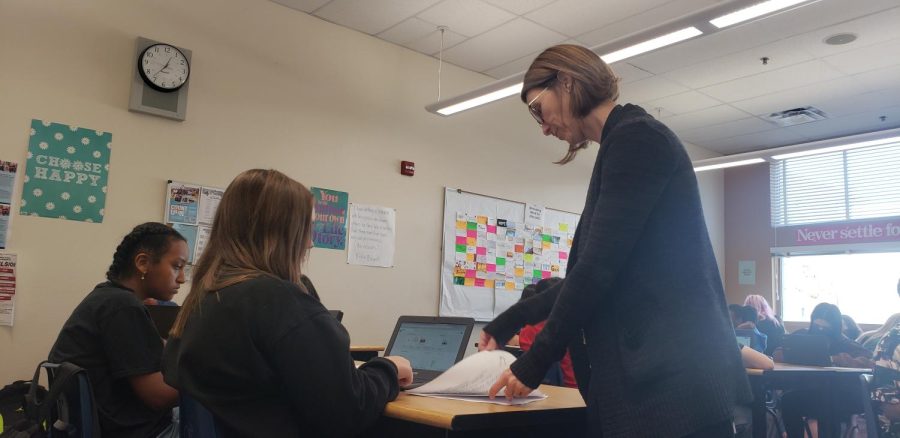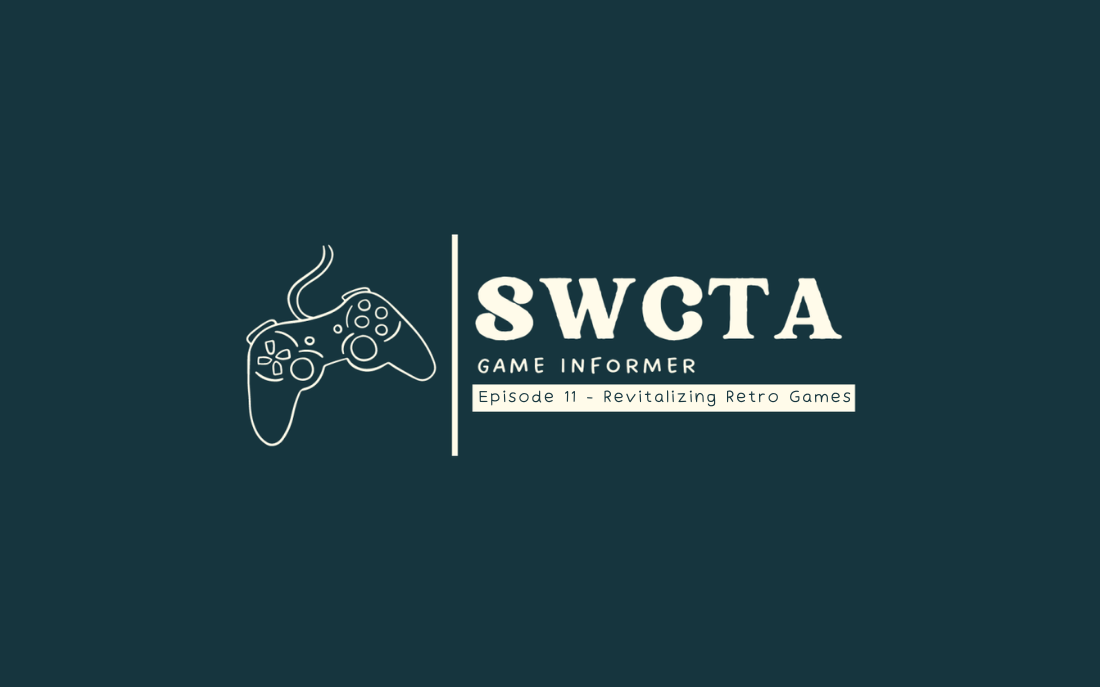Out with the old, in with the new
Modern instruction is shaping the future of learning
Flipping through the printed version of her students’ assignment, English 9H teacher Corrina Terry misses the freedom that the early days of teaching provided with textbooks and paper. She felt she had more lee-way with her students’ learning before COVID-19. “Education today seems very cookie cutter, and it looks like we are heading towards a more standard and uniform way of teaching,” Terry said. “It seems that is what the admin wants now, more uniformity within the classrooms, which I understand, but I just miss some of that creativity that happens without the use of Chromebooks.” Photo Credit: Lily Gurdison
October 11, 2022
As the days of paper and pencil are slowly leaving the classroom, students are trading their worksheets in for computer screens and pencils for keyboards. Although education hasn’t yet taken a full step into the digital age, it’s well on its way. And for veteran teachers, this means facing the challenge of adapting to this rapid change, resulting in an influx of retirements or changes of profession.
“We have gotten so many new teachers, we have turned over almost the entire faculty here at Southwest,” Spanish I/II teacher of 33 years Geri Barnish said. “We have mostly young, and new teachers that are way more adapted to technology than us older folks. It has been hard to modify the [computer-less] lessons I have been teaching for years.”
As new teachers are entering the education field, the increasing amount of technology available is seen as a tool, rather than a restraint.
“I use technology in my classroom to facilitate writing, research and collaboration,” first year English 10 teacher Jenny Byington said. “The internet is a vast resource of information and contains many communities, which I think are great when you are trying to learn something new.”
Because of the COVID-19 pandemic, the shift towards a technological based education became vital. Newer teachers had the upper hand in distance learning, being introduced to modern tactics for effective teaching when students were not physically in the classroom.
“One of the biggest new concepts that was introduced to me during teacher training was remote, hybrid, and distance learning,” Byington said. “I was attending college during the COVID-19 pandemic, so I remember studying The Distance Learning Playbook that was published in 2020 and designing lessons that could be taught in person, remotely, and asynchronously.”
Because the younger generation of teachers may feel inclined to implement the use of technology in all of their lessons, many experienced teachers worry about the effect that the uniformity and increased standards attached to online teaching will have on their own freedom within the classroom.
“What has happened over the years, mainly in the past 15, is that there has been a large influx of guidelines and standards for teachers,” Barnish said. “The district started developing different pacing guides and curriculum requirements, and implemented lots of control over what we needed to do. Our lesson plans were never required to be so rigid and structured. I definitely preferred when we had more freedom regarding classroom expectations and curriculum pacing.”
Additionally, the shift in technological standards has its downsides when it comes to effectively using it in the classroom.
“I’ve had to change my way of being a cheerleader or a champion in order to [get] my students engaged,” English 9 teacher Corrina Terry said. “I try to do things that at least I think would be fun or interesting, but it’s been hard to adapt because everything was paper and pencil really until COVID-19. There’s good and bad. The good thing is that everything is at your fingertips. If you don’t know how to spell something or need a mini lesson on commas, it’s all right there at the students’ disposal. The bad thing is that students can be distracted with games or other classwork.”
Even though technology in the classroom isn’t mandatory, Byington recognises that the actual amount of technology implemented is a teacher choice.
“I believe that the technology is a tool that is available to me as an educator if I wish to use it,” Byington said. “My classroom won’t look like the classroom next door just because we both have Chromebooks. Within my classroom, I think technology actually gives me, as an educator, more of a chance to differentiate instruction. It is so much easier to give personal, individualized feedback to students, look at data, and use that information to shape the decisions that I make as a teacher.”
Agreeing with the varied day-to-day Chromebook use, Barnish finds value in maintaining paper documents and giving students freedom to submit classwork that is digital.
“When the Chromebooks are closed, there is a less likelihood of cheating and a more likelihood of thinking,” Barnish said. “Your ability to recall information is boosted when the answers are not at your fingertips. I do however respect some of the creativity that is happening through the submission of videos and digital art. I have never seen anything like [that] before.”
Along with the modern use of technology, the push for hands-on and collaborative teaching strategies is becoming more prevalent now than ever in this new era of education.
“I have increased collaborative assignments tenfold in class,” U.S. History teacher Jessica Kelly said. “Some of it is due to admin making suggestions and pushing for more student interaction, but I also feel that it is far more beneficial to step back and let my students share their ideas. When I was growing up I never had any of that. No one asked me my opinion and nobody asked me to talk, which I think has contributed to some of the social anxiety I experience now when addressing large groups of adults. I never got that practice when I was in school.”
While the future of education will most likely be deeply rooted in new tactics, there is still much to be learned from the “old school” method from experienced instructors.
“I really admire all of the veteran teachers that I know; they have so many insights and ideas, and I love to learn from them,” Byington said. “In my eyes, they seem more confident and organized, which is where I aspire to be. Every teacher is different, and I think experience just gives you more of a sense of what teaching is and what it can become.”
Hopefully, one thing will remain the same: the need for human connection.
“I don’t think that face-to-face education will ever die; there’s something special about being a part of a classroom community, but I do think that the various options for distance learning will be more widespread,” Byington said. “Just looking at technology in education over the last 10 years, I can confidently say that the technology we will use in education 50 years from now will be far more advanced than it is today. We can’t even begin to imagine it.”









